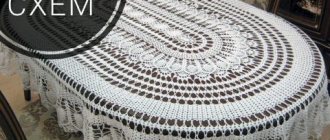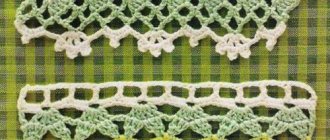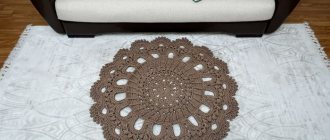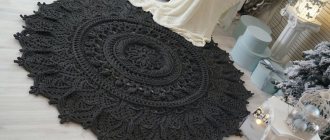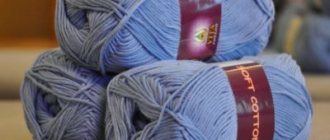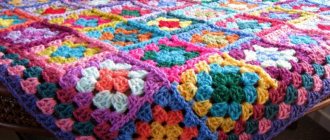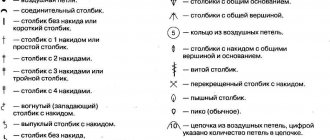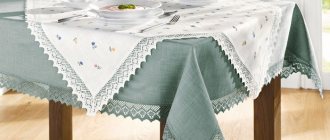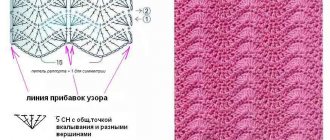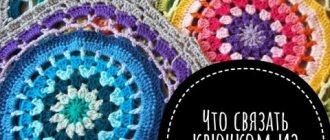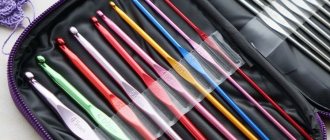- 36001
- 13-10-2020
- Author: Mysekret Team
- 0
Knitted items will help create coziness and a feeling of warmth in the house, and crocheted tablecloths will create a spiritual mood in the kitchen. Many people associate such products with mothers and grandmothers - that is, with their home, warmth and care. Perhaps it's time to create a similar feeling for your loved ones? Crochet patterns and step-by-step descriptions of the work will help with this. And to avoid endless searches for the necessary diagrams and descriptions in magazines and on the Internet, you will need this article.
Crocheting a tablecloth from motifs - materials and thread consumption
Which thread is best to knit tablecloths from is a question that worries everyone who is going to do it for the first time. It’s the same as for napkins - the thinner the thread, the more elegant and beautiful the tablecloth. I would opt for “snowflake” and “lacemaker” or “pelican”, “Anna 16” you can take, they knit tablecloths from “lily”.
You can see the table of different types of threads.
Hook - corresponding to the thickness of the thread, such as is convenient for knitting.
As for thread consumption, it is impossible to give an exact answer; everything will depend on the pattern, the threads, and the size of the table.
You can roughly calculate it based on the numbers that Olga came up with.
Her large rectangular tablecloth measuring 2600 x 1200 cm used 1.5 kg of Lily thread with a crochet size of 1.25.
We count: 2.6 x 1.2 = 3.12 sq.m.
1.5/ 3.12 = 0.48, i.e. per 1 sq. meter needs 480 grams.
If the tablecloth, for example, measures 1.4 x 1.2 meters, it will require:
1.4 x 1.2 x 0.48 = 0.8 - 800 grams of thread.
We hide all the threads that will come from each motif by crocheting them from the inside out. I like to do this right away when knitting each new piece, then by the end of the work it will already be neat and there is no time to waste extra time on these manipulations.
The finished tablecloth will need to be washed by hand in warm water and, if desired, you can starch it.
When wet, we spread it on the floor, stretch and straighten all the elements, corners, peaks, and after drying, iron it from the inside out.
Material selection
Before you begin, you need to decide on the meaning of the tablecloth. The choice of threads and tools depends on the purpose for which it will be created. For everyday use, synthetic yarn is best.
For a festive tablecloth, it is best to use thin fibers made from cotton, linen and iris.
Yarn is usually sold in skeins, where its purpose is indicated. The main element when creating an openwork product with your own hands is a hook. The working tool must strictly correspond to the thickness of the yarn and slide well over it. To do this, you need to know its size, length, diameter and the material from which it is made.
Knitting
Depending on the material of manufacture, hooks are:
- plastic;
- wooden;
- aluminum;
- steel;
- bone.
Aluminum Wooden Bone Plastic Steel
You can easily purchase crochet hooks that suit all parameters. Having chosen the material and tool, you can start working. The yarn must be even in thickness and strong so that the knitted piece is beautiful and durable. The surface of the hook should be smooth, the head should not be very round and sharp. By stretching several loops of yarn for the planned product, you can choose the right tool.
Recommendations for choosing a crochet hook
Beautiful tablecloth made of square crocheted motifs
This is my job, I knitted for a long time, but in the end I got what I wanted. And now my kitchen is so beautiful and cozy! I really liked this particular model that I chose.
At first I tried it on Soso threads, they are, of course, very good and of high quality, but still too thick for a tablecloth, and for the price - this is a rather expensive option, and I made the final choice on Rose threads.
Scheme
The scheme is elementary, you can easily cope with it. True, the motif seemed very small to me and I increased it by two rows.
I would like to remind you that an amazingly beautiful tablecloth with square motifs is made according to a well-known popular pattern, which I have already shown and knitted a napkin from such motifs. You can see the photo, diagram, and description in the post by following the link, I won’t repeat it here.
An important point is preparation for work
As in any other business, correctly selected tools play an important role in knitting: a hook, yarn and a knitting pattern.
- Based on your personal preferences, you can choose the hook material. Today, hooks are made from a variety of materials, such as plastic, wood, steel, aluminum, bone. The hook number indicates its thickness in mm.
- You should choose yarn based on the purpose of your future tablecloth: for example, synthetics and viscose are suitable for daily use, and linen and white cotton are suitable for special occasions.
- The ratio of the chosen yarn and the thickness of the hook is also important: according to the rules, the hook should be as much as twice as thick as the threads.
You can find a huge variety of knitting patterns, but we tried to select for you only the best and most useful patterns.
We wish you creative success and may crocheting according to our patterns bring you pleasure!
Rectangular tablecloth made of simple motifs
tablecloth made of simple openwork motifs - the work of Olga Voloskova
A very interesting openwork motif, such a not hackneyed pattern, yet simple. This tablecloth looks so impressive!
This is the same rectangular tablecloth by Olga Voloskova that I mentioned above.
Scheme
Video
There are some difficulties in combining motifs; we all figured it out together during the knitting process and filming the video. You can also connect not the way I show, but connect the “paths” in the motifs from the wrong side - a double crochet and connect to the main fabric, then you won’t have to break the thread during the joining process.
Sample
It is very difficult to think about how much yarn is needed and how many elements should be knitted for the desired size. A sample helps a lot here. This is a small square or one element of a circle/square for a tablecloth, from which the master can easily count how many loops and how many rows there are in 10 cm .
Usually two indicators are used. Set of first crochet stitches
Two numbers indicate the knitting density and then it is from them that you can determine how many loops or how many pieces are needed for a certain size. But the size of the tablecloth may differ noticeably, so it is better to measure the table and make allowances for free hanging.
Set of the first crochet chain
Openwork tablecloth from motifs
openwork tablecloth made of beautiful motifs - photo from pinterest.com
Well, a very beautiful motif for an openwork tablecloth, its size is so good - with a side of 17 cm. It turns out so elegant!
I tried to knit from “lily” and even it turns out well, in general, it’s probably not necessary to use very thin threads here, any will do.
And the border in it is quite simple, and similar ones are often found in other models, because it is suitable for anyone, it seems to me.
There is a diagram, you can watch the master class in my video.
Scheme
Video
Tablecloth from motifs on an oval table
tablecloth made of motifs on an oval table - photo from pinterest.com
The word “beautiful” is suitable for all motives, including this one!
Look at the magnificent design here: in the center of the motif there are circles and when connected, the four motifs create a kind of drawn circle between themselves.
By the way, you can knit not only rectangular, but also oval tablecloths - the motifs are suitable for all types, as evidenced by the photo.
Scheme
Video
Useful tips for beginning craftswomen
After the tablecloth is ready, it is necessary to carry out a wet-heat treatment. This can be done using an iron and a cloth. The product is laid out with the working side up on the ironing surface, securing the edges with textile needles, and ironed. You can straighten the openwork fabric using a dry cloth by turning on the steaming effect in the iron. This procedure gives the product the desired shape, a beautiful appearance, and hides minor defects.
Beginners should learn to feel the tension of the thread so that the knitted stitches match the pattern in density. When choosing yarn, be sure to pay attention to its uniform thickness, so as not to spoil the finished appearance of the product. It is necessary to monitor the thread change, start a new skein only at the beginning of the row, leaving a long tail for joining. The color of the yarn is chosen according to the personal preferences of the needlewomen.
To extend the service life of an openwork product, you must use hand washing and special products. In the washing machine, the hand-made version becomes deformed and breaks. Therefore, the tablecloth must not only be tied correctly, but also properly cared for.
Beautiful pattern for a tablecloth made of motifs
tablecloth (or bedspread) made of wonderful square motifs - photo from pinterest.com
An unremarkable ordinary square is framed by an intricate border, the paths from which just give the tablecloth charm, tenderness and elegance.
Scheme
Video
part 1
part 2
Three-color tablecloth made of large squares
Just recently I came across this magnificent tablecloth - the photo was apparently from a foreign magazine. It is knitted in large squares with a simple pattern, but precisely because three colors are used here, it turns out very beautiful!
Once upon a time in the old days, they say, grandmothers knitted like this, and now this fashion is becoming relevant.
I got a square measuring 26 x 26 cm. In the center there is a large flower, and along the edge there is an openwork braid. Very easy and interesting to knit.
Scheme
Video
part 1
part 2
part 3 (border)
Knitted tablecloth made of large round motifs
round tablecloth made of motifs - photo from pinterest.com
I really like tablecloths made from round motifs, they are beautiful both rectangular and round. I love patterns that combine large and small intermediate motifs between them.
The main motif of this tablecloth turns out to be very large (about 26 cm in diameter), because it uses double crochets - almost like a small napkin, but you can knit one quickly. Simply gorgeous model!
The edge is decorated with picot elements, it is very beautiful in itself, so there is no border here.
Scheme
Video
part 1
part 2
How to read diagrams correctly
The crochet technique creates openwork for the fabric, does not stretch and saves time. Any pattern selected from the collection is supplied with a diagram. For experienced knitters, one drawing is enough. For beginning craftswomen, in addition to instructions for reading the drawing, a basic dictionary of terms with generally accepted symbols is included:
- report ─ this is a repeating pattern, usually between one and two asterisks in the description;
- cast-on chain ─ this is the initial chain of air loops. The number of loops should always be a multiple of the number of loops in the pattern report, taking into account the lifting ones;
- lifting loops ─ air loop, which is necessary to move from row to row, due to their fabrics are not pulled together;
- arch of air loops ─ a hole formed from a chain of cast-on loops;
- picot ─ used to decorate the edge of a product. Pico loops are not included in the report.
Knitting drawings are always read from bottom to top. The first row, odd, starts from right to left, then even, from left to right, and so on until the end of the report.
How to read crochet patterns
The alternation of cells in the pattern should correspond to the loops when knitting. The numbers on the side indicate the number of rows from bottom to top. On the right for the front sequence, on the left for the purl sequence. The report is repeated as many times as necessary for the product.
Tablecloth made of “Sun” motifs for a round table
tablecloth made of round “sun” motifs - the work of Olga Voloskova
In order to somehow distinguish this tablecloth from the previous one, I called the motifs “suns”; in my opinion, they are very similar.
Scheme
“Mill” motif for a knitted tablecloth
tablecloth made of motifs with a spiral pattern - the work of Olga Voloskova
Look how beautiful this wonderful tablecloth is from the famous popular “mill” motif with a spiral pattern. And pay attention to the diagram - here you can knit one, two or three - extraordinary simplicity! And this pattern is suitable for tablecloths on both round and rectangular tables.
There are no intermediate motifs; the motifs are connected to each other in a checkerboard pattern, creating amazing patterns.
Scheme
Video
In my video, in addition to the tutorial on knitting a motif, I show how to connect them, as well as how to knit a border.
An island of comfort in the home
Such a seemingly ordinary thing as a tablecloth is not particularly noticeable in the interior. But this is only because when thinking through the design of a room, this particular thing is not given due attention. As a rule, it is limited to selecting a tablecloth to match the curtains or other home textiles.
But it is at the table that important family conversations, romantic dinners, and get-togethers with loved ones often take place. It should be comfortable and pleasant to be at the table.
Knitted items themselves carry warmth. And their beauty leaves few people indifferent. A crocheted tablecloth resembles elegant and delicate lace. The love put into every stitch will be felt when looking at the tablecloth. Well, it’s worth remembering that people who are surrounded by beauty and care become kinder and more joyful.
Tablecloth made of large flower motifs
tablecloth made of large floral motifs - the work of Olga Voloskova
Also quite popular is a large motif in the form of large flowers. You can use it to knit napkins and beautiful coasters for cups.
Scheme
Video
Floral motif for a small tablecloth
tablecloth made of small floral motifs - photo from pinterest.com
A very compact, cute round floral motif for a tablecloth, knitted in just 6 rows and they are immediately connected to each other without additional inserts. Knitting is a pleasure and you can get the job done pretty quickly.
